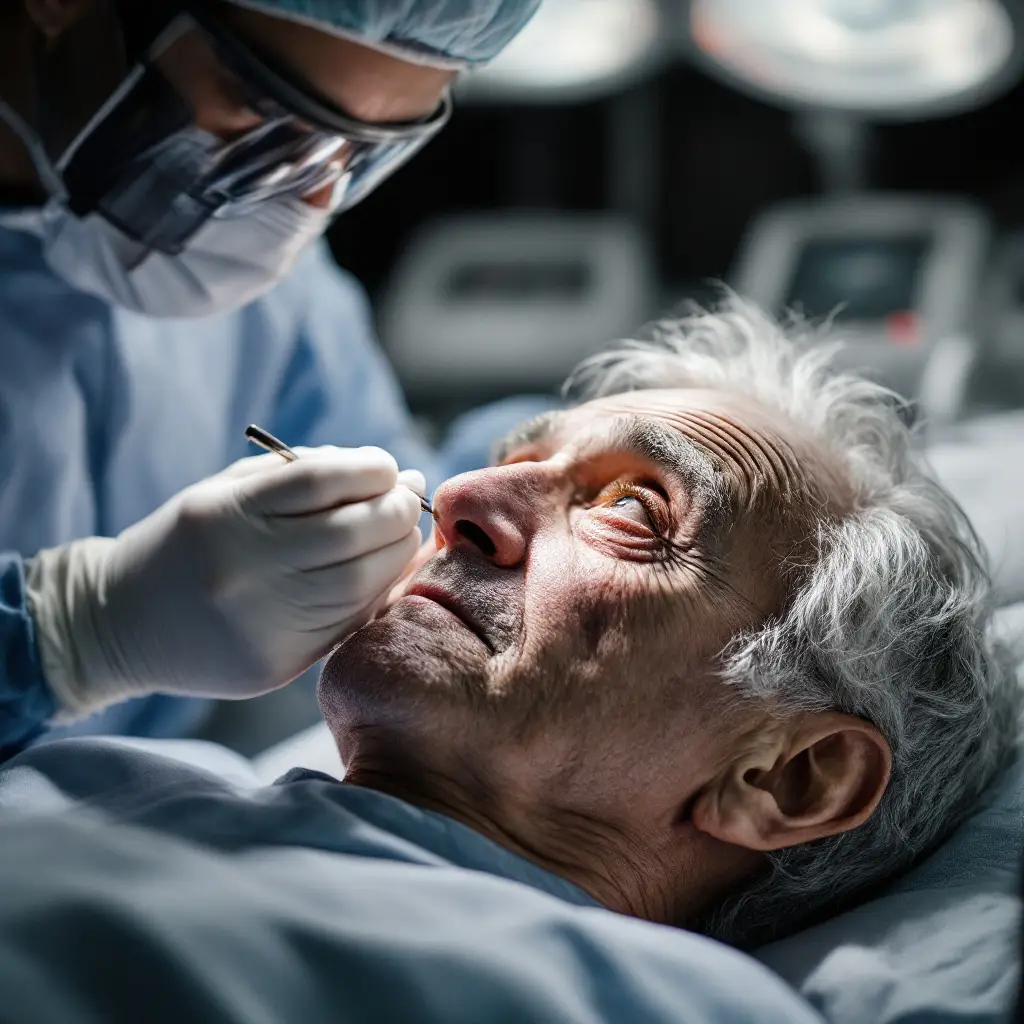In the world of contemporary medicine, cataracts are one of the main causes of vision loss, especially among the elderly population. While surgery is the approved and most effective treatment for cataracts today, scientific research is looking for less invasive solutions. One of the advanced approaches is the development of eye drops that can delay or even reverse the development of cataracts, which could fundamentally change the way this condition is treated.
What is a cataract and how does it affect vision?
Cataract is a condition in which the natural lens of the eye becomes cloudy, which leads to a decrease in visual acuity and the appearance of symptoms such as blurred vision, sensitivity to light and difficulty in night vision. The healthy lens is transparent and allows light to pass smoothly to the retina, but when structural changes occur in it, the light is scattered or blocked, which affects the quality of vision and makes it difficult to perform daily activities.
The need to develop anti-cataract eye drops
Cataract is the leading cause of reversible blindness in the world, and the most common and effective treatment today is surgery to remove the clouded lens and replace it with an artificial lens. Although the surgery is generally safe and effective, it is not without risks and may be inaccessible to certain populations due to costs or a lack of appropriate medical services. The need for non-invasive and more readily available solutions highlights the importance of developing eye drops that can delay, stop or even reverse the process of cataract development.
Advanced studies in anti-cataract eye drops
In recent years, scientific research has focused on identifying and developing active substances that can treat cataracts through eye drops. One of the promising substances is lanosterol, which has shown in animal experiments the ability to reduce the turbidity of the lens by breaking down protein accumulations. Another substance found in the study is N-acetylcarnosine, which is proposed to have antioxidant properties that may delay the progression of cataracts.
Preclinical and initial clinical studies have shown encouraging results, but more research is still needed to determine the efficacy and safety of these drops in humans. Also, understanding the exact mechanisms of action and improving the droplet formulas are some of the challenges facing researchers in this field.

The mechanisms of action of eye drops against cataracts
The drops intended for the treatment of cataracts work mainly by interfering with the biochemical processes that cause the clouding of the lens. One of the ways is to break down the accumulations of damaged proteins in the lens, which are the main cause of cataract development. Certain substances can restore the normal structure of the proteins or prevent their accumulation in the first place. In addition, drops containing antioxidants work to protect the lens from oxidative damage, which leads to structural changes in proteins. By preventing oxidative damage and maintaining protein integrity, the drops can delay or reduce the progression of cataracts .
Active ingredients in drops
Several active ingredients are being researched as a potential treatment for cataracts using eye drops. for nosterol (Lanosterol) It is one of the most prominent substances, which has shown in experiments on animals the ability to reduce the turbidity of the lens by breaking down protein accumulations and restoring transparency. Another material is N- acetylcarnosine (N-acetylcarnosine), a strong antioxidant that can penetrate the lens and protect the proteins from oxidative damage. Substances such as glutathione and carnosine are also being studied for their role in protecting the lens and improving its function. However, it is important to note that most of these substances are still in research stages, and their effectiveness and safety in human treatment have not yet been proven. .
Clinical trial results
Over the past few years, several clinical trials have been conducted in order to test the effectiveness and safety of eye drops as a treatment for cataracts. One of the most prominent studies focused on the use of -N-Acetylcarnosine, which has been suggested as a potential treatment due to its antioxidant properties. Small studies have found some improvement in visual acuity and lens transparency in some patients. However, these studies were limited in scope and duration, and did not provide sufficient evidence to confirm the clinical efficacy of the drops. .
Another study focused on lanosterol, a substance that showed in preclinical experiments on animals the ability to reduce lens clouding. Although the results have been encouraging at this point, extensive human clinical trials have not yet been conducted to confirm the efficacy and safety of lanosterol as a cataract treatment. .
Overall, the existing results indicate a certain potential for eye drops in the treatment of cataracts, but further and more comprehensive research is required to determine the clinical effectiveness and safety of the proposed treatments .
The pros and cons of eye drops against cataracts
The potential advantages of eye drops for cataract treatment include a non-invasive approach, the convenience of self-administration and the reduction of risks associated with surgery. Eye drops can be an available and cheaper solution, especially in areas with limited access to advanced medical services. In addition, they may allow early treatment and delay the progression of cataracts, which can improve the patients’ quality of life .
However, there are also disadvantages and challenges. First, the clinical effectiveness of the drops has not yet been proven in large-scale studies, and there is no official approval for their use as a standard treatment. In addition, the drops may require prolonged and regular use, which may be less convenient for some patients. There are also concerns regarding safety and possible side effects, especially with long-term use. It is important to note that without approval and regulatory oversight, the use of the drops may be dangerous or ineffective .
In conclusion, while anti-cataract eyewashes offer potential benefits as a non-invasive alternative, further research is required to confirm their effectiveness and safety, and they do not at this stage replace surgery as the standard and proven treatment for cataracts .

Limitations and challenges in the development of anti-cataract eye drops
The development of eye drops for the treatment of cataracts has encountered a number of significant limitations and challenges. First, the complex structure of the lens and the natural barriers of the eye make it difficult for active substances to penetrate deep into the lens, where the changes that cause clouding occur. In addition, it is necessary to make sure that the active substances in the drops are stable and safe for prolonged use, without causing side effects or damage to the eye tissues.
Another challenge is the full understanding of the biochemical and physiological mechanisms involved in cataract development. Despite the progress in research, there are still gaps in knowledge that limit the ability to develop targeted and effective treatments. Also, the response to treatment with drops may be slow and require prolonged use, which may reduce patient compliance.
Regulatory restrictions and long approval processes add to the challenge, as extensive clinical studies are needed to prove the efficacy and safety of the drops before marketing them. Funding for these studies may be limited, especially when the existing surgery is considered an effective and safe treatment. All of these factors hinder the development and approval of eye drops as a standard treatment for cataracts.
Surgery as the approved and effective treatment for cataracts
Cataract removal surgery is currently the approved and most effective treatment for cataracts. During the surgery, the cloudy lens is removed and replaced with a clear artificial intraocular lens, which restores the eye’s ability to focus light on the retina correctly. The operation is considered one of the safest and most common surgical procedures in the world, with high success rates and satisfactory results for most patients.
Modern technologies and techniques, such as phacoemulsification and the use of lasers, have reduced the recovery time and the risks associated with surgery. Most surgeries are performed under local anesthesia, and do not require prolonged hospitalization. Patients experience a significant improvement in visual acuity and quality of life, often as early as the day after surgery.
Although the surgery involves certain risks, as with any surgical procedure, they are considered minimal and manageable. Due to the high efficiency and safety of the operation, it remains the treatment recommended by ophthalmologists worldwide, especially when the cataract progresses and affects the daily functioning of the patient.
Summary and future of eye drops against cataracts
The anti-cataract eye drops have the potential to change the therapeutic approach to this condition, by providing a non-invasive and more accessible solution for patients. The studies conducted so far indicate the possibility of delaying or reducing the progression of cataracts using active substances such as lanosterol and N-acetylcarnosine. Preliminary results from preclinical and small clinical studies are encouraging, but the efficacy and safety of these drops in humans have not yet been sufficiently proven.
The challenges in developing effective drops include the need for a deeper understanding of the mechanisms that cause cataracts, improving the penetration of the active substances into the lens, and ensuring the stability and safety of the drops for prolonged use. In addition, large-scale and controlled clinical studies are needed to confirm clinical efficacy and meet regulatory requirements.
In the future, progress in biochemical and pharmacological research may allow the development of effective eye drops as a treatment for cataracts. In this way, it will be possible to provide a non-invasive alternative to surgery, especially for populations with limited access to medical services or for patients who prefer to avoid a surgical procedure.
Meanwhile, surgery remains the approved and most effective treatment for cataracts, with high success rates and significant improvement in vision for most patients. It is important that patients consult with their eye doctors to understand the available options and make an informed decision that is appropriate for their individual situation.
In summary, although the anti-cataract eyewashes show potential and arouse great interest in the scientific community, they are still in the research and development stages. The progress in this field may in the future expand the therapeutic options and improve the quality of life of millions of people suffering from cataracts around the world.





